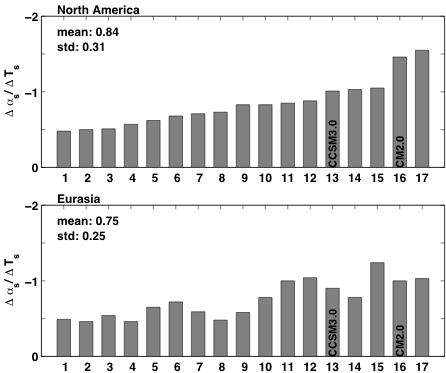
|
||||||||||||||||
|
|

Global Climate Assessing snow albedo feedback in simulated climate
change Based on scenario runs of 17 climate models used in the IPCC 4th
Assessment, the two factors controlling Northern Hemisphere springtime snow
albedo feedback in transient climate change were quantified. The first factor
is the dependence of planetary albedo on surface albedo, representing the
atmosphere' s attenuation effect on surface albedo anomalies. We find in
all simulations surface albedo anomalies are attenuated by approximately
half in Northern Hemisphere land areas as they are transformed into planetary
albedo anomalies (Fig 1). The intermodel standard deviation in this factor
is surprisingly small, less than 10% of the mean. Moreover, when we calculate
an observational estimate of this factor using the satellite-based ISCCP data set, we find most simulations
agree with ISCCP values to within about 10%, in spite of disagreements between
observed and simulated cloud fields. This suggests errors in simulated cloud
fields do not result in significant error in this factor, enhancing confidence
in climate models.
The second factor, related exclusively to surface processes, is
the download the publication describing these results in more detail. |
|
|||||||||||||


